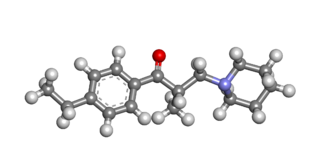An antianginal is a drug used in the treatment of angina pectoris, a symptom of ischaemic heart disease.

Serotonin syndrome (SS) is a group of symptoms that may occur with the use of certain serotonergic medications or drugs. The degree of symptoms can range from mild to severe, including a potentiality of death. Symptoms in mild cases include high blood pressure and a fast heart rate; usually without a fever. Symptoms in moderate cases include high body temperature, agitation, increased reflexes, tremor, sweating, dilated pupils, and diarrhea. In severe cases body temperature can increase to greater than 41.1 °C (106.0 °F). Complications may include seizures and extensive muscle breakdown.
An antispasmodic is a pharmaceutical drug or other agent that suppresses muscle spasms.

Rhabdomyolysis is a condition in which damaged skeletal muscle breaks down rapidly. Symptoms may include muscle pains, weakness, vomiting, and confusion. There may be tea-colored urine or an irregular heartbeat. Some of the muscle breakdown products, such as the protein myoglobin, are harmful to the kidneys and can cause acute kidney injury.
Calcium channel blockers (CCB), calcium channel antagonists or calcium antagonists are a group of medications that disrupt the movement of calcium through calcium channels. Calcium channel blockers are used as antihypertensive drugs, i.e., as medications to decrease blood pressure in patients with hypertension. CCBs are particularly effective against large vessel stiffness, one of the common causes of elevated systolic blood pressure in elderly patients. Calcium channel blockers are also frequently used to alter heart rate, to prevent peripheral and cerebral vasospasm, and to reduce chest pain caused by angina pectoris.
A muscle relaxant is a drug that affects skeletal muscle function and decreases the muscle tone. It may be used to alleviate symptoms such as muscle spasms, pain, and hyperreflexia. The term "muscle relaxant" is used to refer to two major therapeutic groups: neuromuscular blockers and spasmolytics. Neuromuscular blockers act by interfering with transmission at the neuromuscular end plate and have no central nervous system (CNS) activity. They are often used during surgical procedures and in intensive care and emergency medicine to cause temporary paralysis. Spasmolytics, also known as "centrally acting" muscle relaxant, are used to alleviate musculoskeletal pain and spasms and to reduce spasticity in a variety of neurological conditions. While both neuromuscular blockers and spasmolytics are often grouped together as muscle relaxant, the term is commonly used to refer to spasmolytics only.
A depressant, or central depressant, is a drug that lowers neurotransmission levels, which is to depress or reduce arousal or stimulation, in various areas of the brain. Depressants are also colloquially referred to as downers as they lower the level of arousal when taken. Stimulants or "uppers" increase mental or physical function, hence the opposite drug class of depressants is stimulants, not antidepressants.

Rosuvastatin, sold under the brand name Crestor among others, is a statin medication, used to prevent cardiovascular disease in those at high risk and treat abnormal lipids. It is recommended to be used together with dietary changes, exercise, and weight loss. It is taken by mouth.

Malignant hyperthermia (MH) is a type of severe reaction that occurs in response to particular medications used during general anesthesia, among those who are susceptible. Symptoms include muscle rigidity, fever, and a fast heart rate. Complications can include muscle breakdown and high blood potassium. Most people who are susceptible to MH are generally unaffected when not exposed to triggering agents.
Vasospasm refers to a condition in which an arterial spasm leads to vasoconstriction. This can lead to tissue ischemia and tissue death (necrosis). Cerebral vasospasm may arise in the context of subarachnoid hemorrhage. Symptomatic vasospasm or delayed cerebral ischemia is a major contributor to post-operative stroke and death especially after aneurysmal subarachnoid hemorrhage. Vasospasm typically appears 4 to 10 days after subarachnoid hemorrhage.

Doxylamine, sold under the brand name Unisom among others, is an antihistamine medication which is used in the treatment of insomnia and allergies. In combination with pyridoxine (vitamin B6), it is also used to treat morning sickness in pregnant women. Doxylamine is available over-the-counter, and is used in nighttime cold medicines, such as NyQuil, as well as in pain medications containing acetaminophen and codeine, to help with sleep. The medication is taken by mouth.

A conotoxin is one of a group of neurotoxic peptides isolated from the venom of the marine cone snail, genus Conus.

Variant angina, also known as Prinzmetal angina,vasospastic angina, angina inversa, coronary vessel spasm, or coronary artery vasospasm, is a syndrome typically consisting of angina. Variant angina differs from stable angina in that it commonly occurs in individuals who are at rest or even asleep, whereas stable angina is generally triggered by exertion or intense exercise. Variant angina is caused by vasospasm, a narrowing of the coronary arteries due to contraction of the heart's smooth muscle tissue in the vessel walls. In comparison, stable angina is caused by the permanent occlusion of these vessels by atherosclerosis, which is the buildup of fatty plaque and hardening of the arteries.

Cinnarizine is an antihistamine and calcium channel blocker of the diphenylmethylpiperazine group. It is prescribed for nausea and vomiting due to motion sickness or other sources such as chemotherapy, vertigo, or Ménière's disease.

Calcium gluconate is a mineral supplement and medication. As a medication it is used by injection into a vein to treat low blood calcium, high blood potassium, and magnesium toxicity. Supplementation is generally only required when there is not enough calcium in the diet. Supplementation may be done to treat or prevent osteoporosis or rickets. It can also be taken by mouth but is not recommended for injection into a muscle.

Eperisone is an antispasmodic drug.

Ambroxol is a drug that breaks up phlegm, used in the treatment of respiratory diseases associated with viscid or excessive mucus. Ambroxol is often administered as an active ingredient in cough syrup.

Terodiline is a drug used in urology as an antispasmodic.

Tiapamil is a calcium antagonist or calcium channel blocker. It is an experimental drug that has never been marketed.

Cinnamedrine, also known as N-cinnamylephedrine, is a sympathomimetic drug with similar effects relative to those of ephedrine. It also has some local anesthetic activity. Cinnamedrine was previously used, in combination with analgesics, as an antispasmodic to treat dysmenorrhea in the over-the-counter drug Midol in the 1980s. There is a case report of the drug being abused as a psychostimulant.














